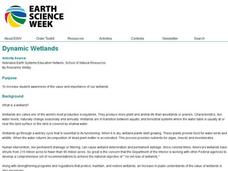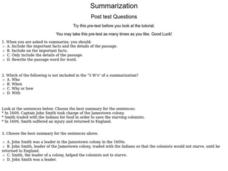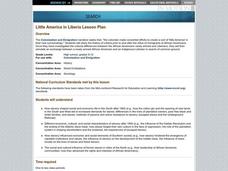Curated OER
Pocahontas
Students, after studying about Pocahontas, identify ways they can deal fairly with others. Given various scenarios, students demonstrate proper social skills. They describe their contributions of peace to their family, school and community.
Curated OER
Modern Day Pilgrims
Students examine the similarities and differences between modern day immigrants and pilgrims. They listen to stories, discuss their ancestors' origins, and create a native costume for a paper doll for where their ancestor is from.
Curated OER
Using Math to Draw the Mayflower
Third graders access information from a website about the Pilgrims trip on the Mayflower and discuss the number of people on the ship and the time they spent on the ship. They draw, label and measure the Mayflower to perspective.
Curated OER
Comparison between Wampanoag and Pilgrims
Second graders compare and contrast the lives of Pilgrims and Wampanoag. Students conduct research using an interactive website and collect information about each group. Students then decide which they would rather be, a Pilgrim or a...
Curated OER
Revolutionary Money
Examine paper money from the American revolution! Historians study the paper bills and discuss the history of money. How has money changed over the times? Activities are included.
Curated OER
My Brother Sam is Dead: A study of the Revolutionary War
Fifth graders complete an analysis of the Revolutionary War through literature. After "My Brother Sam Is Dead," students create a time capsule containing items that would be relevant during the Revolutionary War. They identify key...
Curated OER
Community Symbols: Heroes and Leaders
Students research the importance of community leaders in portraits. In this art history lesson, students look at the painting "The Ascension of Simon Bolivar on Mount Jamaica" and discuss what they see in the portrait. Students research...
Curated OER
The Disappearing Honeybees: Tracking Honeybee Decline
Students practice graphing and other math skills to track number of honeybee colonies present in United States since 1978, discuss major crops that are dependent on insect pollinators, and examine reasons for decline of United States...
Curated OER
Government Goods and Services
Fifth graders investigate the connection between taxes and government services. In this economics lesson, 5th graders discuss the process and benefits of paying sales and income taxes. Using calculators, students compute the amount of...
Curated OER
Social Studies: Exploring Boston's Big Dig
Students, in a high school class for autistic children, take a virtual tour of Boston's "Big Dig" and the artifacts discovered there. During weekly lab sessions, they discover the processes involved in artifact preservation. Using...
Curated OER
Gandhi’s 12 Vows: Training Warriors of Non-violence
Students examine Gandhi’s ‘Walk n Talk’ strategy. In this lesson on civil disobedience, students evaluate Gandhi’s non-violent method of satyagraha as an effective mode of revolution.
Curated OER
Dynamic Wetlands
Students construct and observe a model of two different types of wetlands. In this wetlands lesson, students create a model of a wetland with constant drainage and a wetland that maintains a well-saturated soil. Students observe and...
Curated OER
Colonization
Students explore why the Americas attracted Europeans, why they brought enslaved Africans to their colonies, and how Europeans struggled for control of North American and the Caribbean.
Curated OER
Microbes & History: Microbial influence on the spread of Civilization
Young scholars explore how to extract plant fibers from the flax plant Linum usitatissimum in the process of making linen fibers. Doing so spark interest in the importance of microbial action on the spread of human culture and civilization.
Curated OER
The Information Revolution: A Hypothetical Case
Students consider the implications of the information revolution. In this information age lesson, students discuss informatics and the misuse of information. Students form a fictional bureau of information control and hold a simulated...
Curated OER
Assessing the Character of the Colonies: Rules of Civility and Decent Behavior
Students read a primary source document about the rules of civility and behavior in the presence of company. Using the text, they make assumptions about how life was like in the colonies. They compare and contrast the culture of the...
Curated OER
The Role of African Slaves on South Carolina Rice Plantations
Fourth graders investigate the role of African American slaves in rice plantations. In this slave life instructional activity, 4th graders discuss the products produced in the 13 colonies. Students discuss the importance of rice to South...
Curated OER
Learning To Summarize
For this learning to summarize worksheet, students interactively answer 10 multiple choice questions about summarizing information from a given passage, then click to check their answers.
Curated OER
Settling the Plymouth Colony
Students label blank maps with the names of the New England Colonies. They explain the difficulties that the Pilgrims had and how hard they worked to survive in Plymouth.
Curated OER
Different Viewpoints - Loyalist or Patriot
Third graders use primary sources to study U.S. history and government. In this primary sources lesson, 3rd graders practice gathering information from "eye witness" accounts of history.
Curated OER
Colony of Massachusetts
Third graders recall the reasons why the Pilgrims came to the New World. They ideology and compare and contrast the ideology of the Puritans and Roger iams. They study the colony of New York.
Curated OER
Henry Spelman: The Powhatan Indians' English Boy
Sixth graders read and analyze narrative writing by and about Henry Spelman, a boy-laborer who helped settle Jamestown. They read biographical information, discuss the harsh conditions, and write a narrative piece on Henry's experiences.
Curated OER
Little America in Liberia
Students study the history of Liberia prior to and after the influx of immigrants of African Americans. They investigate the cultural differences between the African Americans and newly-arrived Liberians.
Curated OER
Art or Artifact?
High schoolers analyze and discuss illustrations of the New World by John White. They examine the images, answer questions about each one, and write an essay.

























